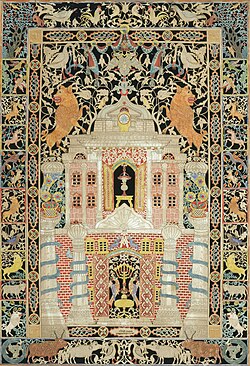Mizrah

| Part of a series on |
| Jews and Judaism |
|---|
Mizrah (also spelled Mizrach, Mizrakh) (Hebrew: מִזְרָח, romanized: mīzrāḥ) is the "east" and the direction that Jews in the Diaspora west of Israel face during prayer. Practically speaking, Jews face the city of Jerusalem when praying, and those north, east, or south of Jerusalem face south, west, and north respectively.[1]
In European and Mediterranean communities west of the Holy Land, mizrah also refers to the wall of the synagogue that faces east, where seats are reserved for the rabbi and other dignitaries. In addition, mizrah refers to an ornamental wall plaque used to indicate the direction of prayer in Jewish homes.
Jewish law

The
The custom is based on the prayer of Solomon (I Kings 8:33, 44, 48; II Chronicles 6:34). Another passage supporting this rule is found in the Book of Daniel, which relates that in the upper chamber of the house in which Daniel prayed three times daily, the windows were opened toward Jerusalem (Daniel 9:3, 6:10).
The
If one cannot ascertain the
Mizrah in synagogue architecture
Excavations of ancient synagogues show that their design generally conformed with the Talmudic and traditional rule on prayer direction. The synagogues excavated west of Eretz Israel in Miletus, Priene, and Aegina all show an eastern orientation. Josephus, in his work Against Apion, recorded that the same was the case for Egyptian synagogues. Synagogues north of Jerusalem and west of the Jordan River, as in Bet Alfa, Capernaum, Hammath, and Khorazin, all face southward, whereas houses of worship east of the Jordan all face west. In the south, the synagogue excavated at Masada faces northwest to Jerusalem. The Tosefta's regulation that the entrance to the synagogue should be on the eastern side, while the orientation of the building should be toward the west was followed only in the synagogue in Irbid.
Initially, the mizrah wall in synagogues was on the side of the entrance. However, the remains of the Dura-Europos synagogue on the Euphrates reveal that by the 3rd century C.E. the doors were on the eastern side and the opposite wall, in which a special niche had been made to place the scrolls during worship, faced Jerusalem. In Eretz Israel, the wall facing the Temple site was changed from the side of the entrance to the side of the Ark in the 5th or 6th century. This change is found in synagogues at Naaran, near Jericho, and Beit Alfa. Worshipers came through the portals and immediately faced both the scrolls and Jerusalem.
Mizrah in Jewish homes

It is customary in traditional Jewish homes to mark the wall in the direction of mizrah to facilitate proper prayer. For this purpose, people use artistic wall plaques inscribed with the word mizrah and scriptural passages like "From the rising (mi-mizrah) of the sun unto the going down thereof, the Lord's name is to be praised" (Psalm 113:3,
There are also papercuts described as "mizrah-shiviti", because they served a dual purpose: as mizrah (decoration for the eastern wall, marking the direction of prayer), and as shiviti, meaning "I have set [before me]" (Psalm 16:8, LXX Ps. 15:8) and intended to inspire worshippers to adopt a proper attitude toward prayer.[2]
Outside Judaism
Like the Jews,
See also
- Direction of prayer
- Ad orientem, the Christian direction of prayer; alternative for Catholic priests: versus populum
- Muslimdirection of prayer
- Baháʼídirection of prayer
- Orientation of churches
- Vytynanky (Wycinanki), Slavic papercuts
References
- ^ a b Mustafa Abu Sway. "The Holy Land, Jerusalem and Al-Aqsa Mosque in the Qur'an, Sunnah and other Islamic Literary Source" (PDF). Central Conference of American Rabbis. Archived from the original (PDF) on 2011-07-28.
- ^ Mizrah/Shiviti, Jewish Museum, New York. Accessed 3 Dec 2021.
- ISBN 978-979-592-701-3.
- ISBN 978-90-04-07819-2.
Further reading
- Elbogen, Ismar (1993). Jewish Liturgy: A Comprehensive History. Jewish Publication Society. ISBN 978-0-8276-0445-2
- "Mizrah" (1997). ISBN 978-965-07-0665-4
